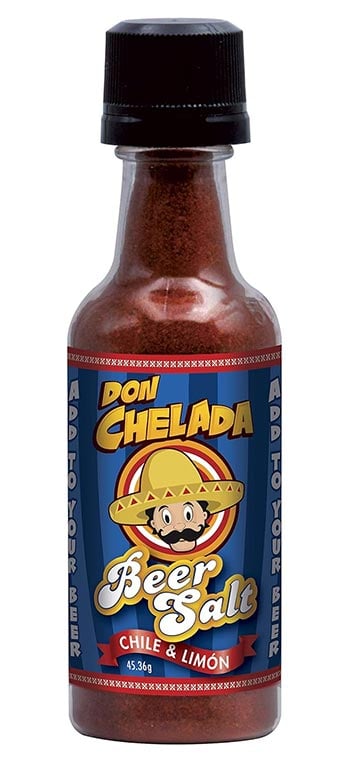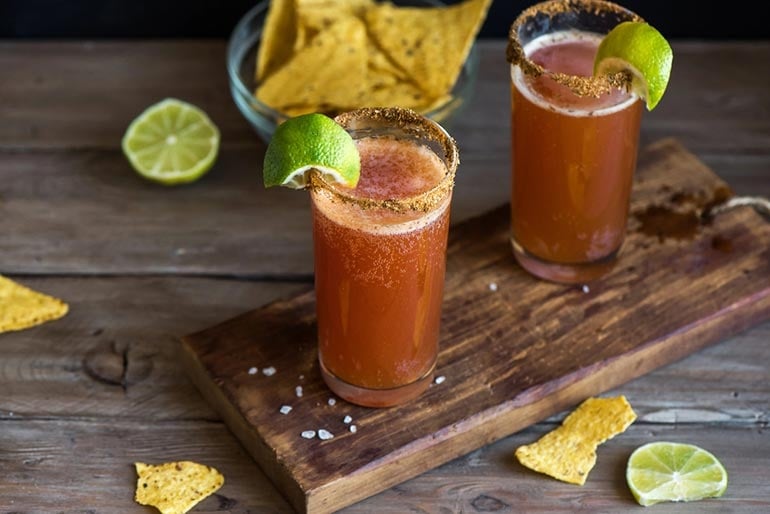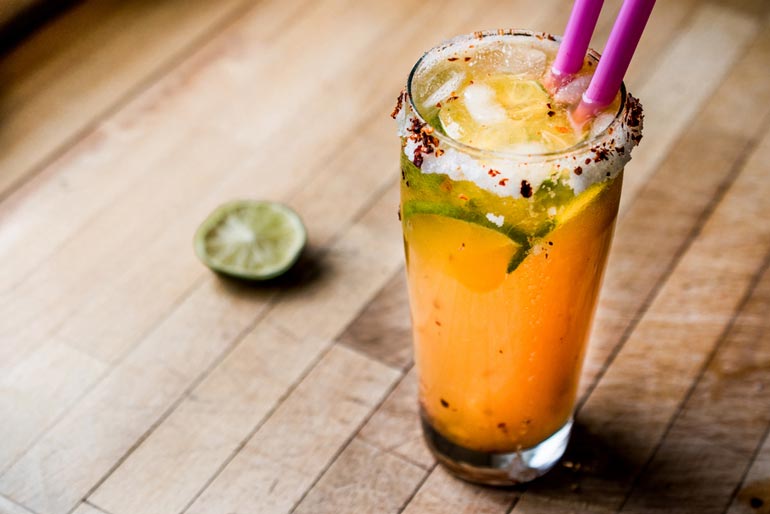Start 14-Day Trial Subscription
*No credit card required

Beer Salt: The Flavored Salt for Your Favorite Brew
Elevate your beer drinking experience with beer salt. Learn about its origin, ingredients and diverse flavors. Discover pairings with different beer styles, try homemade recipes and shop popular beer salt brands.
Are you a beer enthusiast looking to elevate your drinking experience? Enter Beer Salt, which is an exciting new twist that enhances your favorite beverages. Using beer salt boosts the flavor profile of some beers, adding complexity and depth to the taste while subtly balancing its sweetness and bitterness.
Here, we'll discuss the uses of beer salt, the different flavors with beer pairing recommendations, how to make your own homemade salt recipes, shop popular brands, and review safety precautions, all in order to guide you in choosing the right salt to complement your brew. Learn everything you need to know in this guide and become a beer salt aficionado. Cheers to a tastier beer journey!
What Is Beer Salt?
Beer salt is a specialized salt that is formulated to complement the distinct characteristics of beer to boost its flavor in a way that traditional salt does not. Beer salt is sodium chloride blended with other flavoring agents such as lime or lemon zest, cayenne pepper, dried rosemary or thyme and a number of other distinct ingredients.
Origin & History
The origin of beer salt can be traced back to ancient brewing traditions in Mexico, where brewers and beer drinkers would use various herbs and spices, including salt, for a more engaging flavor in beer.
Micheladas are among the most notable examples of beer salt usage. These delectable beverages provide the traditional flavor of beer with a squeeze of lime, a dash of salt and a bevy of additional ingredients, such as citrus, chili peppers and others.
After this long-standing Mexican tradition gained widespread usage around the world, beer salt quickly extended beyond Latino culture and fans of Mexican beer, and adding salt to beer became far more commonplace. Over time, the practice has evolved and a wide variety of carefully curated beer salts are available that harmonize perfectly with various beer styles.
What Ingredients Are Found in Beer Salt?
Beer salt typically contains a combination of ingredients designed to complement the flavors of beer. While formulations may vary between brands and product lines, common ingredients found in beer salt include:
- Salt: The base ingredient, usually a high-quality salt that serves as the primary flavor enhancer.
- Citrus Zest: Citrusflavors, such as lime or lemon zest, provide citric acid and are often added to provide a bright and refreshing element to the salt.
- Chili Powder: Some beer salts may include chili powder or other spicy elements to add heat and complexity to the flavor profile.
- Dried Herbs and Spices: Various dried herbs and spices such as coriander or cumin might be included to contribute additional layers of flavor.
- Dehydrated Vegetables: Dehydrated vegetables like onion or garlic can be used to impart savory notes to beer salt.
- Natural Flavors: Natural flavorings may also be added to enhance the overall taste without relying solely on fresh ingredients.
It's essential to check the product label for specific ingredients as different beer salt brands may have unique formulations. Some brands may also offer specialty or seasonal variations with additional ingredients for a more diverse flavor profile.
Different Flavors & Varieties
There is a diverse array of beer salt flavors and varieties. Here are a few examples:
- Classic Sea Salt: This is a timeless option that can add a subtle brininess to your beer and increase its natural flavors without overpowering the brew. It can be a refined choice if you appreciate a nuanced enhancement to your favorite beer styles.
- Citrus Infusions: Lemon-, lime- or orange-infused beer salts can bring a refreshing kick that's perfect for lighter beers, sour beers or beer that already feature citrusy flavors. You will find this mouth-watering citrus-infused salt can help create a natural lime flavor in beers or provide a counterpoint to beers that feature other citrusy elements.
- Spicy Blends: You can ignite your taste buds with this flavor of beer salts that feature chili, cayenne or other spices. It can deliver a bold and adventurous dimension to your favorite brews. Be assured that these spicy blends will offer delightful flavors.
- Smoky Varieties: Infusing beer salt with smoked sea salt provides a subtle smokiness to beer. Smoky salts are used for robust dark beers as a distinctive element to boost the overall richness of the chosen brew.
- Herbal and Botanical Infusions: Rosemary, thyme or basil-infused beer salts offer an herbal touch to create a harmonious blend with certain beer styles.
- Fruity Options: These are berry-infused or tropical fruit-flavored beer salts that add a sweet and fruity element to serve as a creative contrast with darker brews or complementary element to lighter styles. It is ideal for lighter beers and highly effective if drinkers are looking for a refreshing taste.
How to Use Beer Salt
You can maximize the potential of your beer salt by mastering the art of its application. Here's a step-by-step guide on how to best implement it with your next pint:
Step 1: Moisten the Rim
Before applying salt, make sure that you moisten the rim of your beer glass, bottle or can. You can do it by running a citrus wedge (such as lemon or lime) along the rim or by dipping it in water.
Step 2: Pour Beer Salt
Sprinkle a small amount of salt onto a plate or a specialized beer salt rimmer. Ensure that the salt layer is even for consistent flavor distribution. For bottles or cans, sprinkle the salt directly on the rim.
Step 3: Dip the Glass
Invert the moistened rim of the beer glass into the salt, gently twisting to coat the entire rim. Eventually, the salt will adhere to the moisture and create a flavorful coating.
Step 4: Shake Off Excess
Give the glass a slight shake or tap to remove any excess salt. This step will prevent overwhelming the beer with too much salt while still imparting the desired flavor to each sip.
Step 5: Pour Your Beer
With the salted rim ready, you can now pour your chosen beer into the glass. The first sip will introduce you to the harmonious blend of beer and salt.
Step 6: Experiment with Quantities
You can adjust the amount of beer salt used considering your personal preference. Start with a modest amount and experiment to find the perfect balance for your taste.
Step 7: Clean the Glass After Use
To preserve the integrity of your glassware and avoid any mess, clean it promptly after using to prevent residual salt build-up and ensure a fresh taste for subsequent beers.
Pairing Suggestions
Thoughtfully pairing specific types of beer salt with beer styles can elevate your drinking experience. Check out these intriguing recommendations:
Classic Sea Salt with Lager
Try the clean and crisp profile of lagers with a classic sea salt rim. The subtle brininess complements the light maltiness and gentle mouthfeel to create a refreshing and well-balanced combination.
Citrus Infusions with Wheat Beer
You can elevate the citrusy notes of wheat beer by pairing it with a rim of orange-, lemon- or lime-infused beer salt. The zesty kick will enhance the beer's natural flavors and offer a refreshing and enjoyable experience.
Spicy Blends with IPAs
Intensifying the bold hop flavors of IPAs with a rim of spicy salt can be a great pairing option for you. Chili or cayenne-infused salts add a layer of heat that harmonizes with the beer's hoppy bitterness to create a dynamic taste.
Smoky Varieties with Stouts
You can complement the rich and roasted flavors of stouts by pairing them with a rim of smoky salt. The smokiness of the salt can help create a sophisticated and complex flavor profile for any drinker.
Herbal Infusions with Pale Ales
Explore the herbal side of beer salts with rosemary- or thyme-infused options paired with lightly hoppy pale ales. The herbal notes in the salt can enhance the hoppy and floral characteristics of the beer.
Fruity Options with Fruit Beers
Amplify the fruity elements in fruit beers by choosing a rim of berry-infused or tropical fruit-flavored salt. The sweet and fruity salt can complement the beer's natural fruitiness and provide a "doubling" effect for specific styles.
Homemade Beer Salt Recipes
While there are several fantastic beer salts available to buy and enjoy immediately, what about trying to make your own beer salt at home? With a few common kitchen ingredients, find some inspiration and create your own custom beer salts at home with these easy and flavorful DIY recipes:
1. Citrus Zest Burst
Ingredients:
- 1/4 cup sea salt.
- 1 tablespoon dried lemon zest.
- 1 tablespoon dried orange zest.
Instructions: Combine sea salt with dried lemon and orange zest. Mix well and let it sit for a day to allow flavors to meld.
2. Spicy Heat Infusion
Ingredients:
- 1/4 cup sea salt.
- 1 teaspoon ground chili powder.
- 1/2 teaspoon cayenne pepper.
Instructions: Blend sea salt with chili powder and cayenne pepper. Adjust spice levels to your liking and let it sit for a few hours to infuse.
3. Smoky Mesquite Blend
Ingredients:
- 1/4 cup smoked sea salt.
- 1/2 teaspoon ground black pepper.
- 1/2 teaspoon paprika.
Instructions: Combine smoked sea salt with black pepper and paprika. Mix thoroughly and let it sit for a few hours to develop a smoky and savory profile.
4. Herbal Garden Fusion
Ingredients:
- 1/4 cup sea salt.
- 1 tablespoon dried rosemary.
- 1 tablespoon dried thyme.
Instructions: Blend sea salt with dried rosemary and thyme. Allow the herbs to infuse into the salt for at least 24 hours before use.
5. Tropical Fruit Delight
Ingredients:
- 1/4 cup sea salt.
- 1 tablespoon dried pineapple.
- 1 tablespoon dried mango.
Instructions: Combine Sea salt with dried pineapple and mango, and let the fruity flavors meld with the salt for a tropical infusion for a few hours.
6. Berry Bliss Blend
Ingredients:
- 1/4 cup sea salt.
- 1 tablespoon dried mixed berries (blueberries, raspberries, strawberries, etc.)
Instructions: Blend Sea salt with dried mixed berries and crush the berries slightly to release their juices into the salt to create a sweet and tart blend.
7. Savory Onion & Garlic Infusion
Ingredients:
- 1/4 cup sea salt.
- 1 teaspoon onion powder.
- 1 teaspoon garlic powder.
Instructions: Mix sea salt with onion and garlic powder for a savory and umami-packed beer salt. Let it rest to allow the flavors to meld.
You can experiment with these DIY beer salt recipes and adjust ingredient quantities to suit your taste preferences. Make sure to store your homemade salts in airtight containers to help enjoy your unique creations for a long time.
Alternatives to Beer Salt
Beer salts are superb for aiding the taste of your brew. However, there are some alternatives to these salts that also help improve the flavor of beer tremendously.
Citrus Wedges
Elevate your beer's freshness with a simple citrus wedge as an alternative to beer salt. Run a lemon, lime or orange wedge along the rim of your glass for a burst of citrusy aroma and flavor.
Fruit Garnishes
Experiment with fresh fruit slices like oranges, berries or even cucumber to add a natural sweetness and vibrancy to your beer.
Herbs & Spices
Create a custom blend of dried herbs and spices such as rosemary, thyme or chili powder to complement the flavors of your beer without the use of salt.
Flavored Syrups
Infuse beers with flavored syrups such as ginger, mint or vanilla. A small amount can be added to your beer for a touch of sweetness and aromatic complexity.
Bitters
Experiment with different bitters to add depth to your beer. A few drops of aromatic or flavored bitters can transform the taste without altering the texture.
Vanilla Sugar Rim
You may dip the rim of your glass in vanilla sugar for a sweet and aromatic touch. It will work particularly well sweeter beers, such as pastry stouts or barrel-aged dark beers.
Hot Sauce
Funnily enough, hot sauce can be an alternative to beer salt! For those who enjoy a bit of heat, a drop or two of your favorite hot sauce will add spice and complexity to certain beer styles.

Westbrook Brewing Gose: Rated 94 - Exceptional
Gose: The Historic Salty Beer Style
While beer salt is an additive that can help improve a beer's flavor, there is one sour beer style that often includes salt in its ingredient list: Gose. Pronounced "GOES-uh," this German beer style was created over 1,100 years ago in the town of Leipzig, which has naturally salty water that was used to brew this lightly sour, low-ABV style.
While salt is surely the style's most unusual ingredient, it also features at least half malted wheat in its ingredient -- a far higher amount than most other beers, which employ malted barley more than wheat. That high wheat quotient contributes much to the style's tartness.
The style's thirst-quenching qualities, generally neutral flavor profile and ease of brewing made it a favorite of many U.S. craft breweries during the recent popularity surge of sour beer, as many offerings of the style were produced with a myriad of adjuncts.
Top Beer Salt Brands
As beer cocktails like Micheladas gain popularity, so too does beer salt. There are a few notable beer salt producers in the U.S., such as:
Twang
Twang is a renowned beer salt brand based in the United States and widely recognized for its flavored salts. Twang beer salts, which are available in lime and chili variants, add a zesty kick to your favorite brew.

SHOP ON AMAZON: TWANG BEER SALT
Don Chelada Michelada
Don Chelada produces a variety of flavorful salts in packets, shakers and liquids. They also offer seasoning cups for you to pour your beer into.

SHOP ON AMAZON: DON CHELADA SALTS, CUPS & LIQUIDS
Texas Salt Co.
The Texas Salt Co. offers an impressive variety of artisanal culinary salts, including beer salt, that are sure to stir your inner cowboy or cowgirl. The tequila barrel-smoked lime beer salt looks especially enticing.

Health Precautions
When adding beer salt or any flavor enhancers to your everyday routine, it's important to observe safety precautions to ensure an enjoyable and risk-free experience. Here are some notable areas to take into account:
Check for Allergens
Before using any beer salt, carefully read the ingredients to identify potential allergens. If you have allergies, make sure the product does not contain any substances that may cause adverse reactions.
Moderation is Key
Use beer salt in moderation as excessive salt consumption can lead to health issues including high blood pressure. Stick to recommended serving sizes and be mindful of your overall sodium intake.
Stay Hydrated
Beer salt contains sodium citrate and tricalcium phosphate, both of which can lead to dehydration (as can beer itself). Make sure that you stay adequately hydrated by drinking water alongside your beer consumption, especially if enjoying multiple beverages.
Frequently Asked Questions
We've covered beer salt in depth, but here are a few FAQs that might spring to mind after reading this article.
Is beer salt a Texas thing?
While beer salt gained popularity in Texas, it first began in Mexico. At this point, it has been embraced by beer enthusiasts nationwide because it adds a unique twist to the drinking experience. It has transcended regional boundaries and has now expanded far beyond its Texas roots.
What are the ingredients in Twang beer salt?
Twang beer salt typically blends high-quality salt with delightful citrus zest, chili powder and a mix of dried herbs and spices. Specific formulations may vary to offer a flavorful enhancement to specific beer styles.
What's the difference between beer salt and regular salt?
Beer salt is a specialized seasoning designed to complement the flavors of beer. Unlike regular salt, it often includes citrus zest and various other elements that provide unique flavors.
Can I use any type of salt as a substitute for beer salt?
While regular salt can be used, beer salt is specifically crafted to pair well with the flavors of beer.
How much beer salt should I use per glass of beer?
The amount of beer salt used is subjective and depends on personal preference. Start with a small amount, and adjust to taste accordingly. Remember, it's always easier to add more salt later than to correct an overly salty drink.
Can beer salt be used with non-alcoholic beverages?
Definitely! Beer salt can enhance the flavors of various beverages including non-alcoholic ones. You may experiment with different combinations to discover unique and delicious pairings.
Is this possible to make my own beer salt at home?
Certainly! Refer to our ‘DIY beer salt recipes’ section above.
Can I use beer salt in cooking or food recipes?
Absolutely! Beer salt can add unique flavors to various dishes. You can use it for grilled meats and vegetables, or even as a terrific finishing touch on snacks like popcorn.




